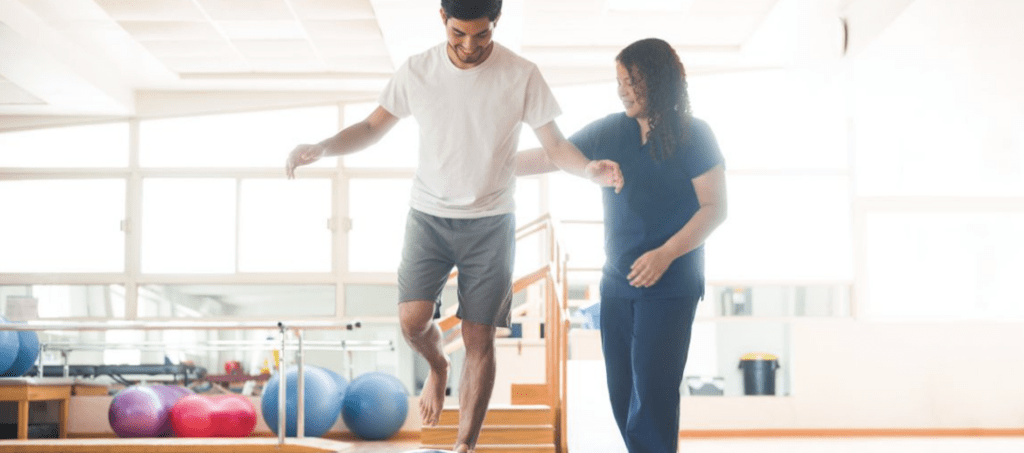Vestibular rehabilitation is an effective treatment for balance problems and dizziness caused by inner ear disorders. Most patients start to experience relief of symptoms and improved balance within 2 to 4 weeks of beginning vestibular therapy. However, it often takes 6 to 12 weeks of regular sessions (1-2 times per week) before the full benefits are felt. Maximum improvements are generally achieved within 12 weeks in most people.

Overview of the Vestibular Rehabilitation Process
Vestibular rehabilitation is a specialized form of physical therapy that stimulates the vestibular system through targeted exercises. This system includes the inner ear and brain pathways that process signals of body movements and position. The goals of vestibular rehab are to promote central nervous system compensation for inner ear deficits, train the brain to rely on alternate sensory inputs for balance, and desensitize maladaptive reflexes.
Therapy begins with an evaluation by a physical therapist trained in vestibular techniques. This allows the therapist to pinpoint which structures are damaged and design an individualized set of exercises. The evaluation may include assessments of eye movements, balance challenges, coordination, and subjective complaints.
The First Few Weeks
The initial exercises are aimed at maximizing visual stability and stabilizing vision when the head is in motion. Slow eye and head movements are practiced, as well as eye-head coordination drills. The intensity and difficulty gradually increase each week as the patient masters the simpler exercises.
After 2 to 3 weeks, dynamic balance activities are introduced. These involve changing head and body positions while maintaining steady posture and vision. Examples include weight shifting side-to-side, marching in place, tossing a ball, and standing on compliant surfaces like foam.
Later Stages
In the later 4-6 weeks, the vestibular therapy becomes more challenging. Exercises now target building endurance, strengthening postural muscles, and improving stability limits. Activities may involve rapid head turns, ambulating with eyes closed, roller coaster head motions, and moving about on unsteady surfaces.
The final weeks shift the focus to maximizing functional mobility for daily life. Challenging dynamic balance tasks are practiced, including head turns while walking forward and backward, stopping/starting suddenly, responding to bumps, and stepping over obstacles.
Most vestibular rehabilitation programs last 6-12 weeks. After the initial supervised therapy ends, patients are given a custom home exercise program to continue improving their skills. Periodic follow-up visits with the therapist are scheduled to advance the program.
Factors Affecting Recovery Time Frame
Several key factors impact how quickly a patient gains benefit from vestibular rehabilitation:
- Cause of Disorder – Compensation occurs faster if only one inner ear is affected, versus bilateral ear deficits. Central nervous system disorders recover more slowly.
- Age – Younger patients tend to improve quicker than older adults due to greater neuroplasticity.
- Health Status – Good cardiovascular fitness, strength, and flexibility lead to faster recovery.
- Frequency of Therapy – More frequent and regular sessions each week produce better outcomes.
- Adherence to Home Exercises – Doing unsupervised practice daily maximizes gains.
- Motivation Levels – Highly driven and committed patients progress faster through the therapy plan.


Vestibular Rehab Exercises
There are several categories of vestibular rehabilitation exercises a physical therapist may utilize:
Gaze Stabilization Exercises
- Keeping the head still while making slow and fast eye movements.
- Turning the head from side-to-side while holding the eyes steady on a target.
Habituation Exercises
- Making repetitive head motions – pitching chin up/down, yawing side to side, rolling head along shoulders.
- Bouncing/swaying while standing, walking, or on foam surface.
- Visual motion sensitivity desensitization training.
Balance and Postural Control Exercises
- Standing in tandem, on a foam pad, or using a balance board.
- Walking exercises with head turns, eyes closed, backwards, etc.
- Reaching to pick objects up while balancing.
- Weight shifting and dynamic stepping drills.
Endurance and Tolerance Exercises
- Extending length of time standing/walking with provoking head motions.
- Increasing intensity of balance challenges and gait tasks.
Functional Mobility Drills
- Everyday tasks – walking changes in direction, stepping over objects,simulated bumps.
- Dual cognitive-motor tasks like ball tossing while seated/standing.
FAQ
How Often Should I Do The Exercises?
For best results, aim to do the exercises 3-5 times per day for at least 10-20 minutes each session. This frequent repetition helps drive neural changes.
When Will I Start Feeling Better?
Most patients experience some relief of dizziness, vertigo, and imbalance within 2-4 weeks. But maximum improvements may take up to 3 months.
How Long Does Recovery Take?
Many patients get clearance to discontinue formal therapy after 6-12 weeks if they’ve reached a plateau. However, continuing with home exercises can yield further gains over 3-6 months.


Take Action Today
If you’re struggling with chronic dizziness or balance problems, vestibular rehabilitation could be the solution. Our specialized physical therapists can evaluate your condition and design a customized therapy program to help improve your stability and coordination. Regain your confidence in performing daily activities safely and reduce risk of falls. Take control of your vestibular disorder and start feeling better today. Contact us now!